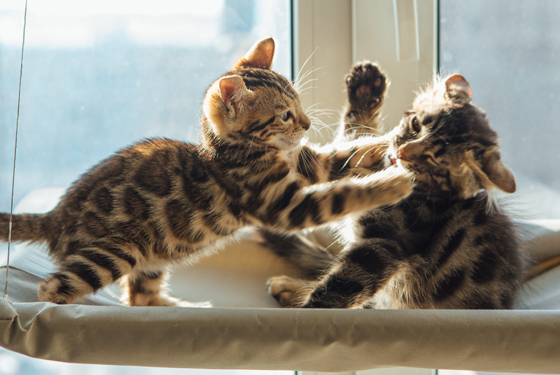Territorial behaviour of cats
Territorial behaviour is not only normal in cats that are allowed outside, but can also be seen in indoor cats. There are several ways of minimising the resulting fights over territory.
How extensive is the territory of a cat?
For wildcats, the size of their territory is crucial for their survival, because only within this area can they go on expeditions to hunt for food. The larger their territory, the greater their chances of catching prey. The situation is similar for stray cats and very independent pet cats that are allowed outdoors. They too try to take hold of as large an area as possible. Cats living in rural areas can claim an area of up to 60,000 square metres as their territory.
In towns and cities, on the other hand, there is much more competition due to the higher cat population. As a result, the territory tends to be considerably smaller and usually covers an area of less than 5,000 square metres. For indoor cats, it is even smaller. Here, the size of their home determines the maximum size of their territory. Nevertheless, all cats display territorial behaviour. Almost anyone who has more than one cat will confirm this.
Territorial behaviour of male and female cats
A cat’s territory is there for it to catch prey. This ensures its survival. For most pet cats that are allowed outside, the survival aspect is of little or no importance, because they are given sufficient cat food at home. Despite this, cats that are allowed outdoors will hunt for prey, for example small birds, in their territory. The size of their territory is therefore of little importance to them.
However, whether its territory is large or small, a cat will always walk along its own regular paths and check for competitors. And then it is time to renew its own markings. To do this, the cat sprays urine at nose level on bushes, trees, fences and house walls. Scratch marks on trees serve as additional markings. These are both clear signs that the territory has already been claimed.
How do cats defend their territory?
Cats generally try to avoid conflicts. As long as others respect their territory, there will be no arguments. In some cases there are even some overlaps that are accepted by both territory holders. However, territorial disputes cannot always be avoided. These are particularly common in unneutered male cats. These can also be the source of the loud screaming that you can sometimes hear at night. If this is not enough to drive its adversary away, a male cat will resort to violence and actively defend its territory.
These fights can look quite vicious and may result in the odd scratch or two. Usually, however, they end without much harm being done, because this is mainly a trial of strength and not an attempt to seriously injure the other cat. Female cats are more restrained, but a cat with kittens is willing to go to any lengths to defend herself and her young within their territory. If you notice any injuries on your pet, you should examine them closely. If they are serious or become infected, you should consult a vet.
Fights over territory in the home
If you have just one pet in your home, you will not need to worry about fights over territory. The cat will simply claim the entire living area for itself and will not have to worry about any competition. Things are, however, different when you have more than one cat living in your home. Here, the cats have to share their territory. This can work really well, but territorial disputes can also occur.
There is rarely a problem when two kittens who know each other, or neutered cats move into their new home. If, however, a second cat is brought into the household or if the cats are not neutered, fights can occur. You should only tolerate these up to a certain point. While hissing or a few single paw swipes can be accepted, you should try to stop a fight. Make sure you protect your hands and forearms with cushions or towels when you separate the feuding cats.

Influencing territorial behaviour in indoor cats
If there are any disputes over territory between your cats, you should check out the situation right there and then. Put yourself in your cat’s place and think about what might be causing the disagreements. Often a lack of facilities is responsible. Every cat needs its own litter tray! And every cat should, without exception, have its own bowls, its own toys, and its own place to sleep. In addition, the cat tree should be large enough for each cat to have its own place to sleep. It may even be a good idea to have two cat trees, so that each cat has its own territory.
Tip: In our article “Getting cats used to each other” you will find numerous tips on how to integrate a newcomer into an existing cat household. If problems arise, it is recommended to keep the new arrival in a separate room for the time being.
Marking behaviour in your home
If you discover urine stains in your home, the question is whether your cat is not properly house-trained or is marking its territory. In the case of insufficient house-training, your pet will usually pass large amounts of urine in the typical squatting position. If, however, the cat is marking, the quantities will be much smaller and the cat will spray the urine while standing. It is important to recognise the difference so that you can react accordingly. To be on the safe side, it is best to consult a vet in order to identify any possible illnesses and to treat them appropriately.
Should it turn out to be a clear case of marking, then it is important to establish the cause. The first question is whether the cat is neutered. If this is not the case, then you may have already found the solution. A virile male cat will want to show all the animals in the neighbourhood that he lives here, even if he is always kept indoors. Neutering is recommended for cats that are allowed outside in any case, because this ensures that they get into fewer territorial fights. If all your cats have already been neutered, the reason for the marking could be stress. Cats are much happier if each of them has its own belongings and basic amenities. You may also like to take a look at your cat’s daily routine. Perhaps there is another way to minimise the stress for your pet.
You may also like this

Getting cats used to each other
This is how you successfully get cats used to each other

Neutring for cats
Neutring has many advantages

Getting your cat used to being outdoors
This is how you get your cat used to being outdoors

Feeding cats with health conditions
In many cases a suitable dietary food can help
